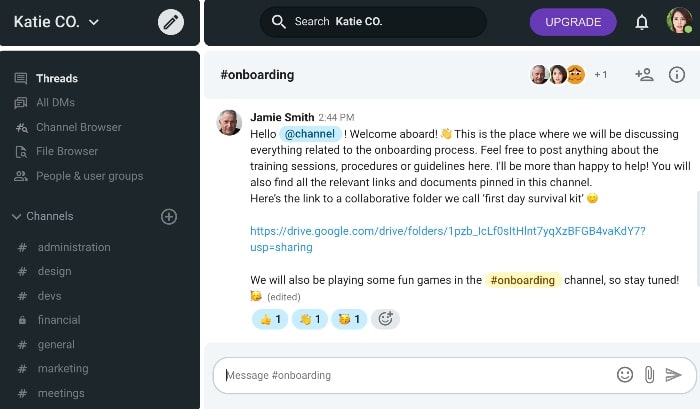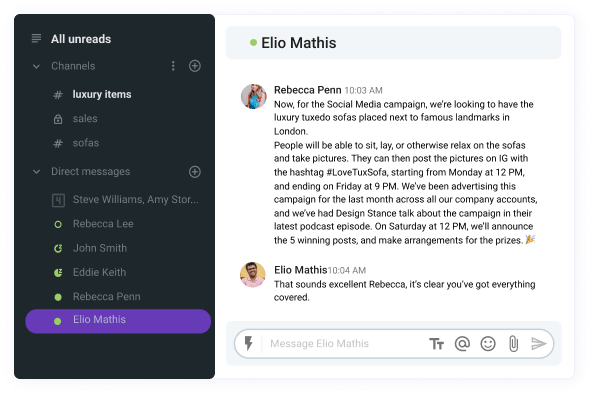Effective communication is the lifeblood of every organization.
Organizations communicate new policies to their employees, prepare them for changes that are about to transpire, and also use communication as a means to bond with one another.
In this blog post, we’ll try to fight organizational problems by showing you what organizational communication is and how best to manage it.
After defining the phenomenon, we’ll:
- Briefly consider the types of organizational communication,
- See some examples of organizational communication, and
- Explain its importance.
Lastly, we’ll offer you some tips on how to create an effective organizational communication strategy.

Table of Contents
What is organizational communication?
Organizational communication is a type of communication that encompasses channels and forms of communication in which organizations (corporations, non-profits, governmental bodies, etc.) engage in. It includes both internal and external communication.
As a subfield of communication studies, organizational communication deals with the communication within an organization via different channels.
The participants in the communication, i.e. employees, work toward a set of common goals.
On the other hand, some more radical definitions suggest that “the communication activity is the organization”. In other words, organizing is, by itself, a communicative activity.
Still not sure what makes communication organizational?
Don’t worry, we have some examples to illustrate our point.
What are organizational communication examples?
Yes, we know, it’s all very well in theory, but let’s look at some examples from our everyday work life.
Some of the examples of organizational communication are the following:
🔸Team meetings — For the teams to communicate effectively, it’s important that they meet on a regular basis (weekly, monthly, etc.), discuss what they’re currently working on, and provide help to one another if needed. If your team has regular meetings, you are practicing organizational communication, although you might not know that or call it that.
🔸Onboarding — Whether you’re welcoming a new employee virtually or in person, at the office, introducing a new colleague to a team or a company is another example of organizational communication.

🔸Feedback — Equally important, but sometimes elusive, constructive feedback is another example of organizational communication.

🔸Social events — Although not always desirable, team bonding and similar events also belong to the organizational communication, albeit, informal, but more on that later.

Now that we’ve seen some examples of organizational communication, let’s consider what types of organizational communication there are.
What are the types of organizational communication?
We can divide organizational communication into four categories:
- Formal and informal communication
- Directional communication
- Internal and external communication
- Oral and written communication
Let’s briefly consider all four types of organizational communication.
Formal and informal communication
Formal communication refers to communication done via emails, meetings, conference calls, speeches, memos, etc.
It follows strict rules, in terms of structure, spelling, and tone.
On the other hand, informal communication or grapevine communication doesn’t involve a strict set of rules.
This type of communication includes chit-chat, messaging via business messaging platforms, phone calls, etc.
Directional communication
Speaking of directions in which communication takes place, organizational communication can be:
- Vertical,
- Horizontal, and
- Diagonal communication.
Vertical communication that takes place from the top down is called downward communication.
In other words, whenever a person in charge communicates with those lower in the hierarchy than them, we have a case of downward communication.
As opposed to that, upward communication refers to communication directed from lower-level workers to their superordinates.
When we communicate with our peers, we participate in so-called horizontal or lateral communication.
Finally, diagonal communication involves members of different teams and departments interacting together, not following strict hierarchical rules by doing so.
Internal and external communication
Organizational communication can also be internal and external, depending on who employees are talking to.
If employees are interacting with one another, within the organization, it’s a case of internal communication. This includes professional communication and collaboration, through various channels of communication (in person, video, email, chat).
When the organization communicates with someone outside the organization, from the external world, we speak about external communication. This includes PR announcements, job posts, marketing materials, and communication with stakeholders.
💡 Pumble pro tip
If you need help with internal communication, we’ll make your life easier with tips on planning internal communication and templates:
Oral and written communication
Lastly, we have oral and written communication, which are both used in organizations, and are therefore an integral part of organizational communication.
Oral or spoken communication is face-to-face communication that takes place between colleagues, or between employees and customers. Its importance in building relationships, both professional and personal, is unquestionable.
Written communication, both formal and informal, occurs via emails, instant messages, and social media. In contrast to oral communication, it is more structured but maybe less personal.
—
Now that we’ve seen what the main types of organizational communication are, let’s consider the importance of organizational communication in the workplace.
Why is organizational communication important in the workplace?
Without effective communication, there is no successful organization.
In his book Administrative Behavior, Herbert A. Simon, an American social scientist, claims that the main role of organizational communication is to battle the glut of information so that we could deal with the most relevant messages.
As information overload is a serious problem, especially in remote communication, we should strive towards overcommunication, but be careful not to dip our toes into information overload.
For that, among other things, we need effective organizational communication.
Namely, effective communication may contribute to organizational success in many ways.
Let’s consider some of the benefits of effective organizational communication.
Organizational communication builds employee morale
Organizational communication gives employees a voice, which is an increasingly meaningful component of improving employees’ satisfaction with their employer.
When employees feel they have opportunities to speak their minds, their overall satisfaction with the job improves. This leads to higher engagement.
Organizational communication lessens the chances for misunderstandings
Effective organizational communication minimizes the chances for miscommunication and leads the way to transparent communication among employees.
When there’s a free flow of information in an organization, the whole workflow becomes more streamlined.
This leads us to the next benefit of organizational communication, which is greater efficiency.
Organizational communication creates greater efficiency
In our search for answers, we reached out to Dominic K. Hawkins, a communication strategist, who shared with us his opinion on the importance of organizational communication.
He highlighted that the best form of communication is one that is two-way since it allows synergies to flow across teams.

“I’ve seen organizations try to apply top-down changes only to have the situation erupt because they failed to secure employee buy-in.
Conversely, I’ve seen employees discuss their dissatisfaction among themselves without a proper channel to management, leading to internal resentment.
In both situations, organizational communication channels would have allowed the free flow of information between all levels and teams of an enterprise to increase operational efficiency, and ultimately yield higher profits.”
Organizational communication boosts productivity
Effective communication in an organization helps companies reach their business goals and has a beneficial impact on their productivity.
Namely, according to Workplace communication statistics (2021), organizations with effective communication plans are 3.5 times more likely to top their competitors.
Having this in mind, it is clear that all employees should make an effort to communicate with one another. It is a cost-effective way to improve productivity, as well as the overall workplace atmosphere.
—
Now that we’ve seen the benefits of organizational communication, let’s consider the ways to create an effective organizational communication strategy.
In the following paragraphs, we’ll present to you seven steps for achieving effective organizational communication.
How to create an effective organizational communication strategy?
To travel farthest, you need a strong team.
To build a strong team, you need to work on your communication.
It really is as simple as that.
Believe it or not, we’ll simplify it even more, by offering you seven steps that’ll lead you to effective organizational communication.
Let’s breast the stream of communication together.
1️⃣ Use great communication tools
First and foremost, if you want to achieve effective organizational communication, you need the best communication tools.
Whether you’re communicating via email or business messaging platforms like Pumble, choose your tools wisely.
Depending on the occasion and information you want to share, you might want to mix up messaging channels.
Don’t be afraid to use several different channels to communicate, because, after all, your goal is that your message reaches each and every one of your employees.
2️⃣ Meet with employees regularly
Whether working remotely, in the office, or anything in between (hybrid work models), make it your priority to meet with your employees regularly.
Nothing beats good old face-to-face communication.
If this is geographically not so easily feasible, make sure you talk with your coworkers via video calls now and then.
Mind you, not all meetings have to deal with business.
There are a number of ways to bond with your coworkers, even when working remotely, and communicate with them more effectively afterward.
3️⃣ Recognize achievements
A healthy work culture, and thereby effective organizational communication, is not possible without employee recognition.
Namely, to motivate your coworkers and keep their morale high, it’s paramount that you acknowledge them for their achievements.
If you do that publicly, even better — you’ll show all your employees what kind of behavior and values are fostered in your organization.
This is an important step towards creating a transparent work culture, where the company’s vision and mission are clear to every member of the team.
4️⃣ Give clear instructions
Fyodor Dostoyevsky once said: “Much unhappiness has come into the world because of bewilderment and things left unsaid.”
So, to avoid misunderstandings and streamline the workflow, you need to communicate your expectations clearly.
Don’t expect your coworkers to read your mind. When giving instructions, make sure everyone understands you.
Ask your team if there is any blurry information they would like you to elaborate on.
Don’t let unclear instructions ruin your workplace communication.
5️⃣ Create an open environment
A natural consequence of clearly communicating with your colleagues is an open environment, in which each of your coworkers feels comfortable to speak their mind.
Management should foster an open-door policy as a sure way to promote transparent vertical communication.
This is the best way to ensure that everyone in your company has access to the same relevant information regardless of their rank in the organization.
An open workplace environment also helps coworkers build stronger relationships among themselves, which is a prerequisite for effective organizational communication.
6️⃣ Use visuals
According to Techsmith’s research, more than 64% of millennials better understand information when it’s communicated visually.
Since millennials now make up one third of the US workforce, they should certainly not be neglected.
Although it may sound daunting, incorporating visuals into your everyday internal communication is a piece of cake. 🎂
All you have to do is add videos, infographics, or GIFs into your daily correspondence and enjoy the fruits of your labor.
Also, don’t refrain from using emojis. Join the 92% of the internet population who use emojis in their everyday communication.
A little disclaimer: First check with your coworkers whether they’re comfortable with the use of emojis in workplace communication.
💡 Pumble pro tip
If you’re not sure whether emojis have their place in the workplace, check out our in-depth article on the use of emojis in business communication:
7️⃣ Be open to feedback
If you want to achieve effective organizational communication, as well as be ready to give feedback to your coworkers, you should be open to receiving it.
As we’ve already mentioned, in order to be effective, communication should be a two-way street.
More importantly, both sides in this communication process should be prepared to actively listen, and acknowledge any criticism, if the other side has valid arguments.
Communication IS organization: Stay organized with Pumble
Without a doubt, organizational communication is what makes a team strong. Without it, you have just a bunch of individuals working in the same virtual or physical environment.
To ensure that your communication is as organized and efficient as possible, have your team use Pumble.
Pumble is a team communication and collaboration app that allows you to:
- Streamline communication,
- Cut down on emails,
- Easily share and search for files and messages you need, and
- Communicate quickly and efficiently.
With Pumble, your team will easily overcome all obstacles of teamwork, avoid miscommunication, increase productivity, and boost team morale!




